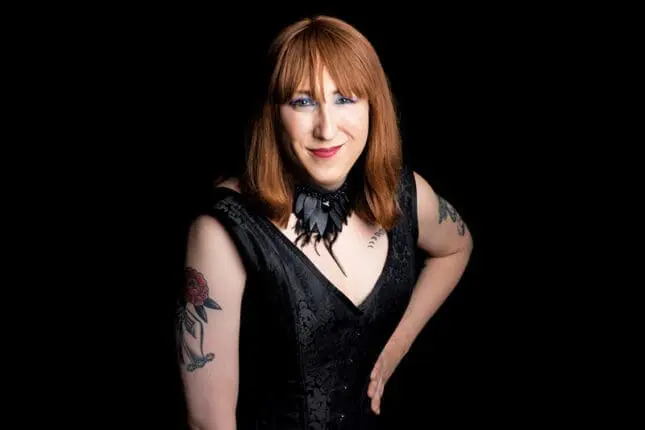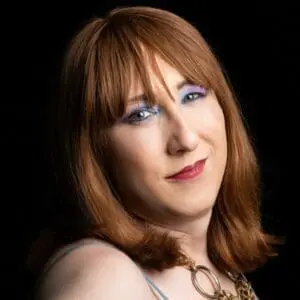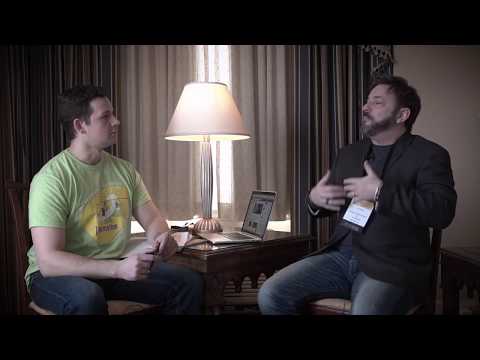As soft, gray, diffuse light streams in through the windows in my bedroom and my eyes flutter open, my gaze alights on a piece on the wall displaying a poem by Vanessa Rochelle Lewis. I focus, as I do every morning, on the last line, written in a bold black serif font: “Recognize the brilliance and divinity of femme and pay respect. You’re welcome for our magical existence.” And, as has been my wont nearly every morning for the last six years, I whisper a prayer in the darkness, “Goddexx, I love being a femme!”
Being femme is so much more than a series of sartorial choices or a form, along with butch, of queer femininities! Femme is resistance. Femme is a mood. Femme is an energy and a singularity. Femme is my queerness. Femme is my gender. Femme is me taking up space as the fiery, passionate, sensual, intense human I am. And femme is lineage, a legacy that includes prominent, badass femmes like Alok Vaid-Menon, Hunter Shackleford, Rachael Anne Jolie, Leah Lakshmi Piepzna-Samarasinha, Amber Hollibaugh, Dorothy Allison, and Joan Nestle. Femme is the flame of the erotic that dances at my core.
In her beautiful and foundational essay, “The Uses of the Erotic,” Black feminist and activist Audre Lorde writes that the erotic “is not a question only of what we do; it is a question of how acutely and fully we can feel in the doing.” This is femme for me—the sense of fullness and joy and pleasure and profound (and sometimes gutting) feeling I experience in my body and in everything I do in the world.
I feel privileged to be able to access so much pleasure in my body and my gender. And in my work with clients, both trans and cis, I try to help support folks in coming into a passionate relationship with how gender and pleasure might show up for them as they move through a world that’s all too often hostile to pleasure and expressions of the erotic. I recognize that there are a variety of reasons why this is deeply challenging for some to access. After all, we’re living in a time of increased policing of bodies, gender, and sexualities, the Dobbs decision being one of the more high-profile examples.
A few months ago, Rebecca Minor, a friend and colleague, posed the following question to her followers on Instagram, most of whom are cis women: “What makes a woman? How do you know you’re a woman (without relying on gendered language or biology/anatomy)?” As a trans femme, I’m often asked by friends, relatives, and colleagues to reflect on my relationship to gender, with questions like, “How did you know you’re not a man?” Or, “When did you first realize that you wanted to transition?” But we rarely ask cis women or cis men how they know they have the gender identities they hold.
I’ve asked a lot of cis women in my life this question. And the responses, both to my question and to that which Rebecca posed on social media, have been revealing. Some women have answered by talking about womanhood as affording them a kind of freedom, flexibility, and fluidity that they felt masculinities didn’t often afford. For instance, one woman spoke of the freedom to play with a variety of presentations—fun clothes, makeup, hair styles. Another woman felt that she had more ability to express emotional ranges not often afforded to cis men in many Anglo-American cultural contexts, and she took pleasure in a kind of feminine ethic of care and solidarity.
These are examples of taking pleasure in gender—of women who felt in a variety of ways a sense of joy in womanhood. This can exist side-by-side with an acknowledgement of the impacts of sexism. The two women I just talked about are fiery feminists (and gender-studies professors to boot). Both said they’d like to live in a world free of misogyny and other structures of oppression, but that being women made them happy in some fundamental way.
Other women who responded to this question defined their relationship to their gender identity in much different terms. They spoke of their sense of womanhood as being rooted in experiences of—or susceptibility to—gender-based violence and oppression. One respondent answered, “I know I’m a woman because I’m treated like one.” She was referring to having experienced too many instances of misogyny to count. Others defined their relationship to womanhood as feeling physically vulnerable, being groped, and enduring sexually harassment. Another wrote about having to engage in “compensatory measures like hair removal, dressing feminine, and using a nonconfrontational tone of voice” that felt uncomfortable to her.
Of course, I’d like to see a world where these forms of discrimination and violence are no longer such prominent aspects of people’s gendered realities. But as we struggle, fight, and agitate for that world, we need to have a sense that we’re not just fighting against oppression, but for a world with expanded possibilities for pleasure and connection—to our bodies, our selves, our partners, our friends, our communities, and our planet. Our task is not merely to survive or be gritty or resilient, but to thrive and flourish! Pleasure, particularly an aspect of pleasure I call gender-pleasure, are essential to that flourishing.
I’ll start with a personal story. Two years ago, I underwent top surgery (aka breast augmentation). Apart from the tattoos that I’ve had inked onto my body, this surgery was the most incredible and affirming body mod I’ve pursued. I love my breasts. I love how they fill out the clothing I select, and how, as a result of their size and shape, my center of gravity and the ways that I move have subtly shifted. As a lover of evocative language, I enjoy using expressions such as decolletage, cleavage, and ample, heaving bosom to describe my augmented chest tissue. I even delight in how they draw the eyes of others, though I should hasten to specify that I only really enjoy drawing the eyes of other queer humans.
To be clear, I didn’t pursue the surgery for anyone else’s pleasure or because I thought I’d be, I don’t know, “cis-assumed.” I didn’t do it because I felt like I needed to resolve any gender or body dysphoria (this was a substantial side effect, but not the actual point). I did it because I wanted it, and because doing it would give me a tremendous amount of gender-pleasure. My goal was to reach for how pleasure and the erotic might live in—and be expressed through—my body. I wanted to imagine into how gender might itself be “an elaborate sex toy,” to borrow a metaphor from one of my favorite erotic short stories, “Strong,” by Xan West, a trans butch leatherdyke.
Gender-pleasure is the pleasure one can feel in one’s embodied experience of gender, whether that’s feeling affirmed in one’s gender within social, sexual, or intimate contexts—or just feeling yummy in one’s body at a given moment.
I’m not the first person to talk about the importance of experiencing joy in and with gender. I’m building, in part, on the concept of gender euphoria, which biomedical ethicists Florence Ashley and Carolyn Ells define as the “distinct enjoyment or satisfaction caused by the correspondence between the person’s gender identity and gendered features associated with a gender other than the one assigned at birth.”
Gender euphoria is a solid concept, but I don’t use it anymore for three reasons. First, I think it sounds too clinical. Second, I hear the word euphoria and think it might lead us to think only in terms of an ecstatic state, that we need the heavens to part and a choir of angels to chant to the music of the spheres for us to feel yummy in our bodies. In other words, euphoria feels a bit unattainable and rarefied. Finally, because gender euphoria is often defined in binary opposition to gender dysphoria, some people might (reasonably) assume that it’s a state of being enjoyed solely by trans and nonbinary folks. And frankly, I think cis people can and should get in on the fun!
Gender-pleasure, in contrast, feels approachable, accessible, quotidian, and available to people of all genders. And shouldn’t feeling pleasure in one’s gender be a right to which we are all entitled? As much as I want women to take pleasure in being women, I want men to take pleasure in being men; I just want them to do so in a way that doesn’t play into toxic masculinity.
Attuning to Gender-Pleasure: Two Activities
To help individuals access gender-pleasure, I often offer my clients a few activities, one of which is a journaling exercise I’ve adapted from sex educator Tuck Malloy called a gender-pleasure history. You may even want to try it yourself! To start, take a minute or two to reflect on this question: What’s your experience of gender-pleasure in your life? Allow the question to seep into your pores and move through you. Find a quiet place where you won’t be disturbed and set a timer for 10 minutes. Then write down how you’ve experienced pleasure in or with gender throughout your life. You might use a timeline format.
If you’re more creative-arts inclined, you might also start to recognize things that evoke and promote gender-pleasure by creating what I’ve come to call a gender-pleasure mood board. Using images from books and magazines, fabric swatches, small objects, and even words, you can create a collage or mood-board that evokes ways that—or contexts in which—you experience gender-pleasure.
Here’s a gender-pleasure history that I wrote:
Age 9 or 10: For my birthday one year my godmother got me a Barbie. She didn’t last long—my father threw a holy fit over it—but goodness did I love that I had one, just like the ones I coveted when I spent time with my girlfriends. I loved her long, flowy dress. I think it had cherries on it?
Age 12 or 13: The dawn of the internet, and I got an AOL account. I hung out in the Star Trek chat rooms, and the persona I created was a 19-year-old Romulan woman. I loved that in those online spaces I could show up any way I wanted to—pointy ears, angular features, severe countenance, cunning disposition, and all.
Age 16-18: When I was a teen, I used to go dancing on goth nights at Houston-area clubs. In the darkness punctuated by strobe lights, I delighted in how my body moved to the music and lyrics of the songs played. My friends teasingly referred to the style of dance as the “kick-strut.” But my body felt so lithe and graceful as I danced to songs like “Temple of Love” by Sisters of Mercy or “Melt!” by Siouxsie and the Banshees.
Age 21: A habitué of the live Rocky Horror Picture Show whenever I was back home in Texas, I was asked to perform “Sweet Transvestite” to close out a variety show in college. My friends banded together to ensure that I was decked out with garters, stockings, bustier, a glorious, long mane of hair. At the end of the night, having rocked that performance, I settled between the sheets in my dorm room and noticed a frisson of excitement when my smooth, recently shaved, bare legs brushed against one another.
Age 23/24: I hooked up with K, another queer grad student, for the first time. Despite my outwardly masc-of-center gender presentation, the sex we had felt so goddamn queer! She even said that she felt like she was having sex with another woman.
Age 29: For my wedding to my wife, S, I had a special suit tailored. It was navy blue with bold lilac and purple pinstripes. I felt so bright, festive, and femme in that suit, despite the fact that suits are most often coded as masc.
Ages 43-44: I get my first tattoos in July 2021, both super queer (a deconstructed progress pride flag on my inner right forearm; a “fiery femme” script tattoo on my inner right forearm). Over the course of a year, I end up getting another eight pieces. I love how the tattoos adorn my body, accentuating my arms in particular. And when I go to the gym to powerlift (another gender-pleasure activity), I wear clothes that show off the designs.
I could’ve written more, had I allotted myself even more than 10 minutes. But the point of the activity is not to be comprehensive or exhaustive. And there are no wrong responses! Rather, the aim of the activity is to begin to attune oneself to the ways pleasure has shown up in our embodied experiences of gender as we move through the world.

“When I first went about writing my gender-pleasure history, I had a rough time of it,” lamented Jessica, a cis straight woman and college professor in her late 30s. “All I could think of at first was all the sexist bullshit I’ve had to deal with in my professional life.”
Jessica worked at a major research university and had come to me because she was having panic attacks about coming up for tenure and was staring down a phalanx of dismissive cis male colleagues who believed her work just wasn’t rigorous enough. We spent a lot of time in our sessions unpacking how this was a sexist attitude, and, on a hunch, I asked her to come up with a gender-pleasure history. As we explored how gender-pleasure has been a part of her life, she began to speak about how much she’d valued being engaged in feminist causes and activist spaces in grad school. Eventually, she came to see that the problem wasn’t with her, but with the patriarchy. And, ultimately, she became more confident in her academic writing, considering it a zone of resistance and autonomy that she could carve out in an otherwise oppressive workplace environment.
For most of us, I’ve learned, the move to consider taking pleasure in our gender can be challenging, at least at first. This can be attributed in part to negative cognitive bias, which is necessary for our survival but means that when we scan our bodies and environments, we’re much likelier to focus on potential threats or negative experiences than on potential sources of pleasure, excitement, ease, and positive appraisals of ourselves and others.
I’m not by any stretch of the imagination a “live, laugh, love” or “positive vibes only” kind of gal, but I think it is vitally important to engage in practices that cultivate a deepening into how gender-pleasure lives in and moves through our bodies. I think that an engagement with gender-pleasure can be particularly important at times like these, when, again to reference Audre Lorde, we’re told over and over in ways both subtle and decidedly not, to minimize, ignore, or outright fear “the yes inside ourselves, our deepest cravings.”
For trans folks, attuning to gender-pleasure allows us to resist cultural scripts that all too often seek to center trans experiencing around gender dysphoria and its resolution. But attuning to gender-pleasure can be a radical act of resistance for cis folks too! We all need pathways to imagine, to dream, and to make manifest the liberation we crave.
PHOTO © JEN FOX BOUDOIR AND EROTICA
Lucie Fielding
Lucie Fielding, LMHCA, is a queer, trans misogyny-affected (TMA) femme, and a therapist practicing in Virginia and Washington State (on Monacan and unceded Duwamish land, respectively). She’s also a sex educator and the author of Trans Sex: Clinical Approaches to Trans Sexualities and Erotic Embodiments, which was named a 2022 Lambda Literary Award finalist and the winner of a 2022 AASECT Book Award. Contact: luciefielding.com or @sexbeyondbinaries on Instagram.














